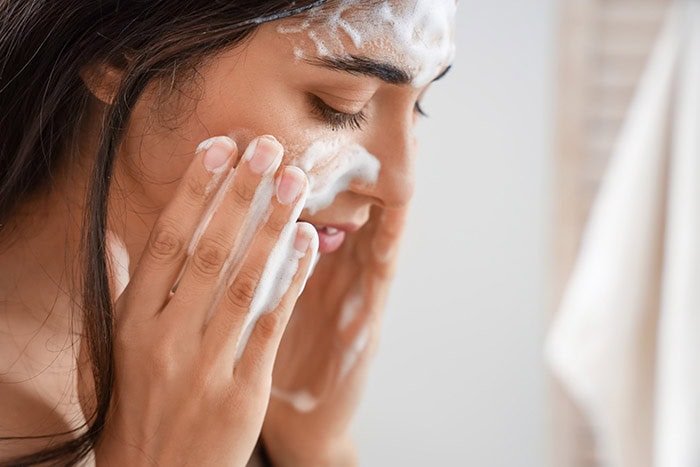Showering and Botox Aftercare
Botox anti-wrinkle injections are a popular treatment for softening lines and wrinkles with very little downtime, but the first 24 hours of aftercare play an important role in achieving the best results. Many patients ask whether it’s safe to shower after Botox, how hot the water can be, and what else they should avoid to prevent side effects.
The key is to keep things gentle — avoiding heat, pressure, or vigorous rubbing so the Botox has time to settle properly.
At my cosmetic skin clinic in Wimbledon, I’m often asked by patients from Raynes Park, Kingston, Surbiton, Richmond, and across South West London, whether it’s safe to shower after Botox and how hot the water can be. Let’s go through what you need to know about showering, washing your face, and keeping your skin safe after Botox injections.
Can I Shower After Botox Treatment?
Yes, you can — but timing and temperature matter. A light, lukewarm shower is safe once the 4–6 hour window has passed, provided you avoid scrubbing your face or letting strong jets of water hit the treated areas.
Think of it as giving your skin a calm, gentle environment to heal. Harsh showers, heavy steam, or powerful water pressure too soon after treatment can interfere with the way Botox settles and may increase the risk of swelling or bruising.
For the first 24 hours, stick to quick, mild showers and use soft, patting motions if you need to dry your face. Keeping things gentle helps ensure your results look smooth and natural.
Gentle, thoughtful aftercare – including how you shower, exercise, and protect your skin from heat – helps your Botox look soft and natural. I explain my approach in my guide to getting a natural look with Botox.
Anything that leaves your face hot and flushed – such as sunbeds, saunas, or steam rooms – can increase the risk of swelling and bruising after treatment. If you use tanning beds, you may find my article on sunbeds and Botox – what you need to know helpful.
Many patients also ask about the gym and classes – for a detailed breakdown of what’s allowed and what to avoid, see my guide on how soon after Botox you can exercise.
How Soon Can You Shower After Botox?
It’s best to wait at least 4–6 hours before showering after Botox. This gives the injections time to bind to the muscles without being disturbed by water, steam, or rubbing the skin. After this period, a gentle, lukewarm shower is perfectly safe.
If possible, avoid very hot water for the first 24 hours. Heat can increase blood flow to the treated area, which raises the risk of swelling, bruising, or the Botox spreading from where it was carefully placed. Long, steamy showers, saunas, and hot tubs should all be avoided during this time.
A simple rule of thumb: keep your shower short, warm (not hot), and gentle for the first day after treatment. This helps your skin recover smoothly and ensures the Botox settles exactly where it should.
Alongside heat and pressure, alcohol can also increase bruising and swelling in the early stages. If you drink socially, you may want to read my guide on drinking alcohol after Botox.
Many people like to combine a shower with a workout, but in the first day after Botox it’s best to keep both the water temperature and your activity level gentle. If you’re unsure, my guide on how soon after Botox you can safely exercise explains what to avoid.

A gentle shower a few days after Botox is perfectly safe once the initial aftercare period has passed.
Is Hot Water or Steam Safe After Botox Injections?
No — it’s best to avoid hot showers, steam rooms, or saunas for at least 24–48 hours. Heat dilates blood vessels, increases circulation, and may cause Botox to migrate from where it was carefully placed.
Excessive heat can also make swelling or bruising worse and may leave the treated area feeling uncomfortable. Even a long, hot shower at home can have the same effect. Keeping your skin cool, calm, and free from heat exposure in the first two days after treatment is the safest option. Once this period has passed, you can gradually return to your normal routine.
Sunbeds and strong sun exposure can have a similar warming and drying effect on recently treated skin, so I’ve written a separate guide on sunbeds and Botox – what you need to know.
Can I Wash My Hair After Botox in My Forehead?
Yes, you can wash your hair on the same day, but you should be cautious about how you do it. In the shower, tilt your head back so hot water, shampoo, or conditioner doesn’t run directly over your forehead too soon.
It’s also best to avoid bending forward for long periods (such as over a sink) in the first 4–6 hours after treatment, as lying flat or leaning down can affect how Botox settles into the targeted muscles. Using a gentle shampoo and lukewarm water helps minimise any risk of irritation while keeping your results protected.
Alongside showering, people also ask about naps and bedtime after their appointment – if that’s on your mind, see my article on how long after Botox you can lay down.
Is It OK to Wash Your Face After Botox?
Yes, but it’s important to be gentle. You can safely cleanse your face after Botox, but avoid rubbing, scrubbing, or applying heavy pressure for at least the first 24 hours. Pat your skin dry with a clean towel rather than wiping or pressing.
Use a mild, fragrance-free cleanser and cool or lukewarm water to keep irritation to a minimum. Avoid exfoliating products, chemical peels, retinol creams or facial scrubs for at least two days, as these can overstimulate the skin and increase redness. A light moisturiser can be applied carefully, but skip heavy facials, masks, or massage until after the initial healing window.

Washing your face after Botox is fine — just keep it gentle and avoid rubbing for the first 24 hours.
What Must You Not Do After Botox?
Botox is a very safe and effective treatment, but certain factors can reduce its effectiveness or even cause uneven results if not taken seriously. Most of these are within your control, which is why good aftercare is so important.
The main things that can interfere with Botox include:
- Drinking alcohol too soon – increases bruising, swelling, and slows healing.
- Vigorous exercise in the first 24 hours – raises circulation and may cause Botox to spread away from the target muscles.
- Excessive heat exposure – saunas, steam rooms, hot tubs, sunbeds, and prolonged sunbathing can all reduce results.
- Not following aftercare advice – touching, rubbing, or lying flat too soon after injections increases the risk of uneven results.
- Certain medications such as aspirin or ibuprofen (unless prescribed)
Showering is just one part of the first 24–48 hours after treatment. Following simple Botox aftercare advice helps to minimise bruising, swelling, and the risk of uneven results.
At my Wimbledon aesthetic clinic, I take the time to explain aftercare clearly and answer any questions, so patients leave feeling confident about what to do — and just as importantly, what to avoid.
| ❌ Risk Factor | 🔎 Why It Matters |
| Drinking alcohol too soon | Increases bruising, swelling, and slows recovery |
| Vigorous exercise (first 24 hrs) | Raises circulation, may spread Botox from target area |
| Excessive heat (sauna, sunbed, tanning) | Dilates blood vessels, reduces Botox longevity |
| Ignoring aftercare advice | Rubbing, massaging, or lying flat too soon can cause uneven results |
| Certain medications | Aspirin or ibuprofen – unless prescribed |
These precautions help the Botox stay exactly where it should, giving you the best natural results.
Additional Questions People Ask
Can I Take a Bath After Botox?
It’s best to avoid hot baths for the first 24 hours. Heat and steam can increase circulation and cause swelling or bruising. A quick, lukewarm bath is usually safe after the first 6 hours, provided the water isn’t too hot and you avoid long soaks. Keep your face above the waterline and don’t submerge the treated area.
Can I Use the Gym Showers After Botox?
Yes, you can — but remember the bigger concern is the exercise itself. Strenuous workouts should be avoided for at least 24 hours after Botox. If you’re showering at the gym the following day, keep the water cool to lukewarm and avoid steam rooms or very hot showers. This reduces the risk of swelling and ensures your Botox settles properly.
Can I Go Swimming After Botox?
It’s best to wait 24–48 hours before swimming. Pools expose your skin to chlorine and bacteria, which may irritate injection sites. In addition, goggles or tight-fitting face masks can place pressure on the treated areas, potentially affecting how Botox settles. After two days, swimming is safe as long as the treated skin feels comfortable and fully healed.

Swimming is safe once 24–48 hours have passed after Botox — giving your skin time to settle first.
Final Thoughts
You don’t have to avoid showers completely after Botox — just be mindful of when and how you wash. Waiting a few hours, keeping water lukewarm, and being gentle with your skin makes all the difference in protecting your results.
📍 If you’re considering Botox in Wimbledon, Raynes Park, Kingston, Surbiton, Putney, or anywhere in South West London, I’d be happy to guide you through safe aftercare and treatment plans tailored to your lifestyle.
During your free consultation, we’ll discuss your skin concerns, assess your facial structure, and decide together which treatment aligns best with your needs.
Book your free consultation here →
Or call me directly: 07702 389 636
Warm regards,
Dr Suresh Mohan
Contact Dr Suresh Mohan
Considering Book FREE consultation! My clinic is dedicated to providing this advanced skin rejuvenation technique, ensuring top-notch care in the heart of London.
If you have a specific question, want to book a free consultation or request a call back, please fill in the form below, and I will get back to you as soon as possible.
By clicking ‘Send enquiry‘ you agree to Dr Mohan Clinic’s Privacy Notice.







